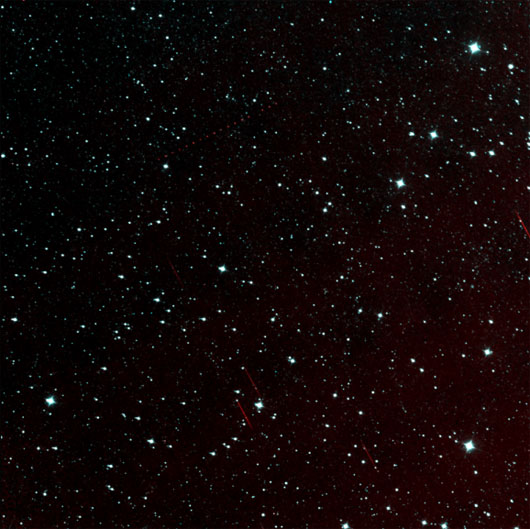NEOWISE ships back after starting a new mission
The NEOWISE probe (new name according to WISE's mission to detect dangerous objects near Earth) sent the first test images , taken with 40cm telescopes and infrared cameras in preparation for new mission after being reactivated by NASA in August last year. Aiming to find potentially dangerous meteorites and classifying objects near Earth, the US Aerospace Agency says NEOWISE will be a powerful tool to explore, list and learn about celestial bodies inside the solar system.
>>>NASA re-activates the WISE probe
Among the deep-space images sent by the ship, NASA has discovered t- porch (872) Holda - once discovered in 1917. This is a meteorite with a diameter of 42km and located in the celestial belt. Jelly between Mars and Jupiter. NASA said images from NEOWISE allow scientists and engineers on Earth to evaluate the quality of the observations of ships.

The image sent by NEOWISE shows the path of the Holda meteorite (red dotted line)
Launched on September 14, 2009, NEOWISE is essentially a broad-spectrum infrared telescope and takes on the mission of surveying the entire sky in search of fuzzy objects such as brown dwarfs. IR spectra. The ultra-sensitive telescope on the vessel is cooled to - 266 degrees Celsius by introducing solid hydrogen-containing cooling chambers. WISE's main mission ended when the cooling hydrogen was exhausted and in February 2011, the vessel was put on hold after completing a four-month extension mission. However, since September, WISE has begun a new mission called NEOWISE after 31 months of inactivity.
The ship is currently located in the solar orbit, 525km from Earth and a full circle around the globe every 95 minutes. The new NEOWISE mission, which lasts three years, will focus on finding potential objects that threaten to Earth or towards a mission to explore meteorites as part of the American Meteorite Launch program. NASA expects the unmanned probe to detect at least 150 objects near the new Earth (NEO) and will study the size, maturity and thermal properties of more than 2000 meteorites. To cool down to the temperature required when solid hydrogen is exhausted, the telescope on NEOWISE will periodically return to deep space so that heat can be released.
Amy Mainzer - a researcher from the NEOWISE program at NASA's JPL lab in Pasadena, California, said: 'NEOWISE not only gives us a better understanding of the meteorites and comets that are being studied directly. but also helps us refine mission ideas and plans for the future, inventory missions and sorting objects near the Earth from space. The ship is in good operating condition and the new images are still as high quality as before it was put on leave. For weeks and months to come, we will accelerate data processing activities and hope to return to meteorite hunting. "
- Six outstanding space missions are underway
- All female crew tested moon mission
- NEOWISE detects new asteroids
- The Rosetta probe will end its mission on September 30
- Russia plans to bring people back to the Moon
- Dragon spacecraft fulfilled its mission of supplying ISS
- NASA revealed the whole mission mission 22.5 days back to the Moon
- Russia is about to launch unmanned ships on Mars
- Asteroid hunter wakes up
- Locate the answer for Europe's Mars mission
- Astronauts have left piles of manure on the Moon and we will have to bring it back
- NASA discovered 72 asteroids that could collide with the Earth
 Van Allen's belt and evidence that the Apollo 11 mission to the Moon was myth
Van Allen's belt and evidence that the Apollo 11 mission to the Moon was myth The levels of civilization in the universe (Kardashev scale)
The levels of civilization in the universe (Kardashev scale) Today Mars, the sun and the Earth are aligned
Today Mars, the sun and the Earth are aligned The Amazon owner announced a secret plan to build a space base for thousands of people
The Amazon owner announced a secret plan to build a space base for thousands of people